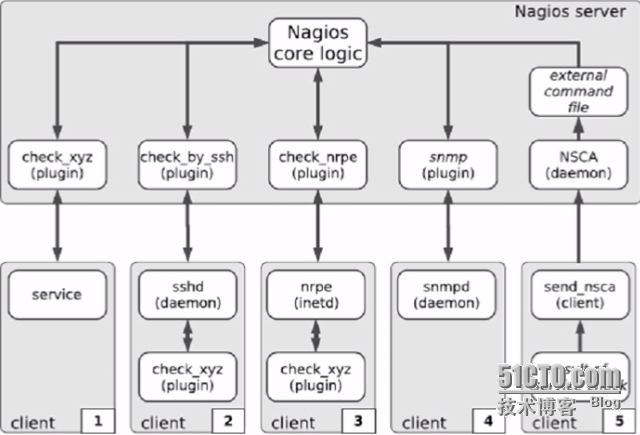Nagios利用NRPE监控Linux主机
一、简介
1、NRPE介绍
NRPE是Nagios的一个功能扩展,它可在远程Linux/Unix主机上执行插件程序。通过在远程服务器上安装NRPE插件及Nagios插件程序来向Nagios监控平台提供该服务器的本地情况,如CPU负载,内存使用,磁盘使用等。这里将Nagios监控端称为Nagios服务器端,而将远程被监控的主机称为Nagios客户端。
Nagios监控远程主机的方法有多种,其方式包括SNMP,NRPE,SSH,NCSA等。这里介绍其通过NRPE监控远程Linux主机的方式。
NRPE(Nagios Remote Plugin Executor)是用于在远端服务器上运行监测命令的守护进程,它用于让Nagios监控端基于安装的方式触发远端主机上的检测命令,并将检测结果返回给监控端。而其执行的开销远低于基于SSH的检测方式,而且检测过程不需要远程主机上的系统账号信息,其安全性也高于SSH的检测方式。
2、NRPE的工作原理
NRPE有两部分组成
check_nrpe插件:位于监控主机上
nrpe daemon:运行在远程主机上,通常是被监控端agent
注意:nrpe daemon需要Nagios-plugins插件的支持,否则daemon不能做任何监控
详细的介绍NRPE的工作原理
当Nagios需要监控某个远程Linux主机的服务或者资源情况时:
首先:Nagios会运行check_nrpe这个插件,告诉它要检查什么;
其次:check_nrpe插件会连接到远程的NRPE daemon,所用的方式是SSL;
然后:NRPE daemon 会运行相应的Nagios插件来执行检查;
最后:NRPE daemon 将检查的结果返回给check_nrpe 插件,插件将其递交给nagios做处理。
二、被监控端安装Nagios-plugins插件和NRPE
1、添加nagios用户
[root@ClientNrpe ~]# useradd -s /sbin/nologin nagios
2、安装nagios-plugins,因为NRPE依赖此插件
[root@ClientNrpe ~]# yum -y install gcc gcc-c++ make openssl openssl-devel [root@ClientNrpe ~]# tar xf nagios-plugins-2.0.3.tar.gz [root@ClientNrpe ~]# cd nagios-plugins-2.0.3 [root@ClientNrpe nagios-plugins-2.0.3]# ./configure --with-nagios-user=nagios --with-nagios-group=nagios [root@ClientNrpe nagios-plugins-2.0.3]# make && make install #注意:如何要监控mysql 需要添加 --with-mysql
3、安装NRPE
[root@ClientNrpe ~]# tar xf nrpe-2.15.tar.gz [root@ClientNrpe ~]# cd nrpe-2.15 [root@ClientNrpe nrpe-2.15]# ./configure --with-nrpe-user=nagios > --with-nrpe-group=nagios > --with-nagios-user=nagios > --with-nagios-group=nagios > --enable-command-args > --enable-ssl [root@ClientNrpe nrpe-2.15]# make all [root@ClientNrpe nrpe-2.15]# make install-plugin [root@ClientNrpe nrpe-2.15]# make install-daemon [root@ClientNrpe nrpe-2.15]# make install-daemon-config
4、配置NRPE
[root@ClientNrpe ~]# grep -v ‘^#‘ /usr/local/nagios/etc/nrpe.cfg |sed ‘/^$/d‘ log_facility=daemon pid_file=/var/run/nrpe.pid server_port=5666 #监听的端口 nrpe_user=nagios nrpe_group=nagios allowed_hosts=192.168.0.105 #允许的地址通常是Nagios服务器端 dont_blame_nrpe=0 allow_bash_command_substitution=0 debug=0 command_timeout=60 connection_timeout=300 command[check_users]=/usr/local/nagios/libexec/check_users -w 5 -c 10 command[check_load]=/usr/local/nagios/libexec/check_load -w 15,10,5 -c 30,25,20 command[check_hda1]=/usr/local/nagios/libexec/check_disk -w 20% -c 10% -p /dev/hda1 command[check_zombie_procs]=/usr/local/nagios/libexec/check_procs -w 5 -c 10 -s Z command[check_total_procs]=/usr/local/nagios/libexec/check_procs -w 150 -c 200
5、启动NRPE
#以守护进程的方式启动 [root@ClientNrpe ~]# /usr/local/nagios/bin/nrpe -c /usr/local/nagios/etc/nrpe.cfg -d [root@ClientNrpe ~]# netstat -tulpn | grep nrpe tcp 0 0 0.0.0.0:5666 0.0.0.0:* LISTEN 22597/nrpe tcp 0 0 :::5666 :::* LISTEN 22597/nrpe
有两种方式用于管理nrpe服务,nrpe有两种运行模式:
-i # Run as a service under inetd or xinetd -d # Run as a standalone daemon
可以为nrpe编写启动脚本,使得nrpe以standard alone方式运行:
[root@ClientNrpe ~]# cat /etc/init.d/nrped #!/bin/bash # chkconfig: 2345 88 12 # description: NRPE DAEMON NRPE=/usr/local/nagios/bin/nrpe NRPECONF=/usr/local/nagios/etc/nrpe.cfg case "$1" in start) echo -n "Starting NRPE daemon..." $NRPE -c $NRPECONF -d echo " done." ;; stop) echo -n "Stopping NRPE daemon..." pkill -u nagios nrpe echo " done." ;; restart) $0 stop sleep 2 $0 start ;; *) echo "Usage: $0 start|stop|restart" ;; esac exit 0 [root@ClientNrpe ~]# chmod +x /etc/init.d/nrped [root@ClientNrpe ~]# chkconfig --add nrped [root@ClientNrpe ~]# chkconfig nrped on [root@ClientNrpe ~]# service nrped start Starting NRPE daemon... done. [root@ClientNrpe ~]# netstat -tnlp Active Internet connections (only servers) Proto Recv-Q Send-Q Local Address Foreign Address State PID/Program name tcp 0 0 0.0.0.0:22 0.0.0.0:* LISTEN 1031/sshd tcp 0 0 127.0.0.1:25 0.0.0.0:* LISTEN 1108/master tcp 0 0 0.0.0.0:5666 0.0.0.0:* LISTEN 22597/nrpe tcp 0 0 :::22 :::* LISTEN 1031/sshd tcp 0 0 ::1:25 :::* LISTEN 1108/master tcp 0 0 :::5666 :::* LISTEN 22597/nrpe
三、监控端安装NRPE
1、安装NRPE
[root@Nagios ~]# tar xf nrpe-2.15.tar.gz [root@Nagios ~]# cd nrpe-2.15 [root@Nagios nrpe-2.15]# ./configure > --with-nrpe-user=nagios > --with-nrpe-group=nagios > --with-nagios-user=nagios > --with-nagios-group=nagios > --enable-command-args > --enable-ssl [root@Nagios nrpe-2.15]# make all [root@Nagios nrpe-2.15]# make install-plugin #安装完成后,会在Nagios安装目录的libexec下生成check_nrpe的插件 [root@Nagios ~]# cd /usr/local/nagios/libexec/ [root@Nagios libexec]# ll -d check_nrpe -rwxrwxr-x. 1 nagios nagios 76769 9月 28 08:07 check_nrpe
2、check_nrpe的用法
[root@Nagios libexec]# ./check_nrpe -h NRPE Plugin for Nagios Copyright (c) 1999-2008 Ethan Galstad ([email protected]) Version: 2.15 Last Modified: 09-06-2013 License: GPL v2 with exemptions (-l for more info) SSL/TLS Available: Anonymous DH Mode, OpenSSL 0.9.6 or higher required Usage: check_nrpe -H <host> [ -b <bindaddr> ] [-4] [-6] [-n] [-u] [-p <port>] [-t <timeout>] [-c <command>] [-a <arglist...>] Options: -n = Do no use SSL -u = Make socket timeouts return an UNKNOWN state instead of CRITICAL <host> = The address of the host running the NRPE daemon <bindaddr> = bind to local address -4 = user ipv4 only -6 = user ipv6 only [port] = The port on which the daemon is running (default=5666) [timeout] = Number of seconds before connection times out (default=10) [command] = The name of the command that the remote daemon should run [arglist] = Optional arguments that should be passed to the command. Multiple arguments should be separated by a space. If provided, this must be the last option supplied on the command line. Note: This plugin requires that you have the NRPE daemon running on the remote host. You must also have configured the daemon to associate a specific plugin command with the [command] option you are specifying here. Upon receipt of the [command] argument, the NRPE daemon will run the appropriate plugin command and send the plugin output and return code back to *this* plugin. This allows you to execute plugins on remote hosts and ‘fake‘ the results to make Nagios think the plugin is being run locally.
通过NRPE监控远程Linux主机要使用chech_nrpe插件进行,其语法格式如下: check_nrpe -H <host> [-n] [-u] [-p <port>] [-t <timeout>] [-c <command>] [-a <arglist...>] [root@Nagios libexec]# ./check_nrpe -H 192.168.0.81 NRPE v2.15
3、定义命令、主机、服务
本文出自 “郑彦生” 博客,请务必保留此出处http://467754239.blog.51cto.com/4878013/1558897
郑重声明:本站内容如果来自互联网及其他传播媒体,其版权均属原媒体及文章作者所有。转载目的在于传递更多信息及用于网络分享,并不代表本站赞同其观点和对其真实性负责,也不构成任何其他建议。







































